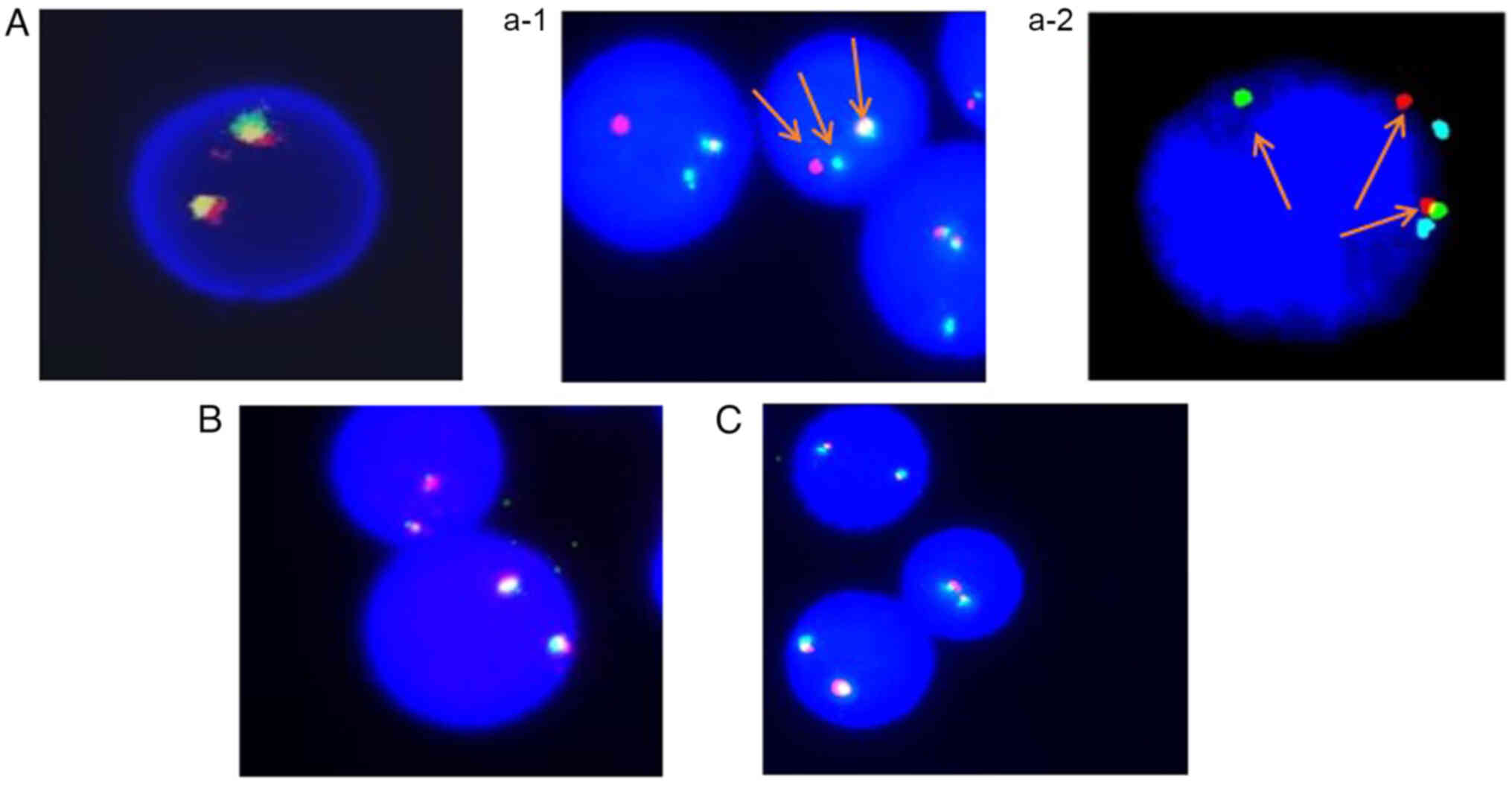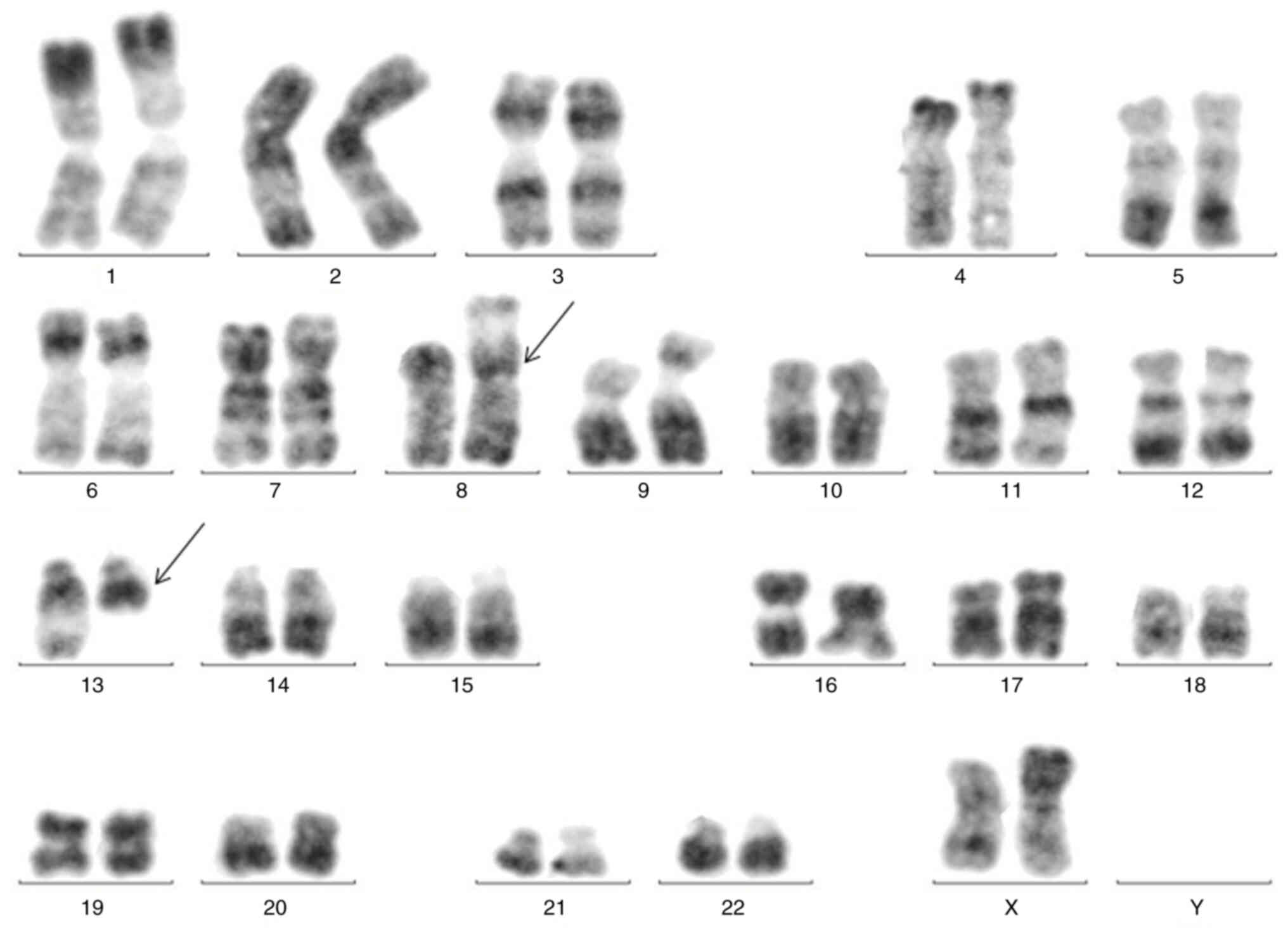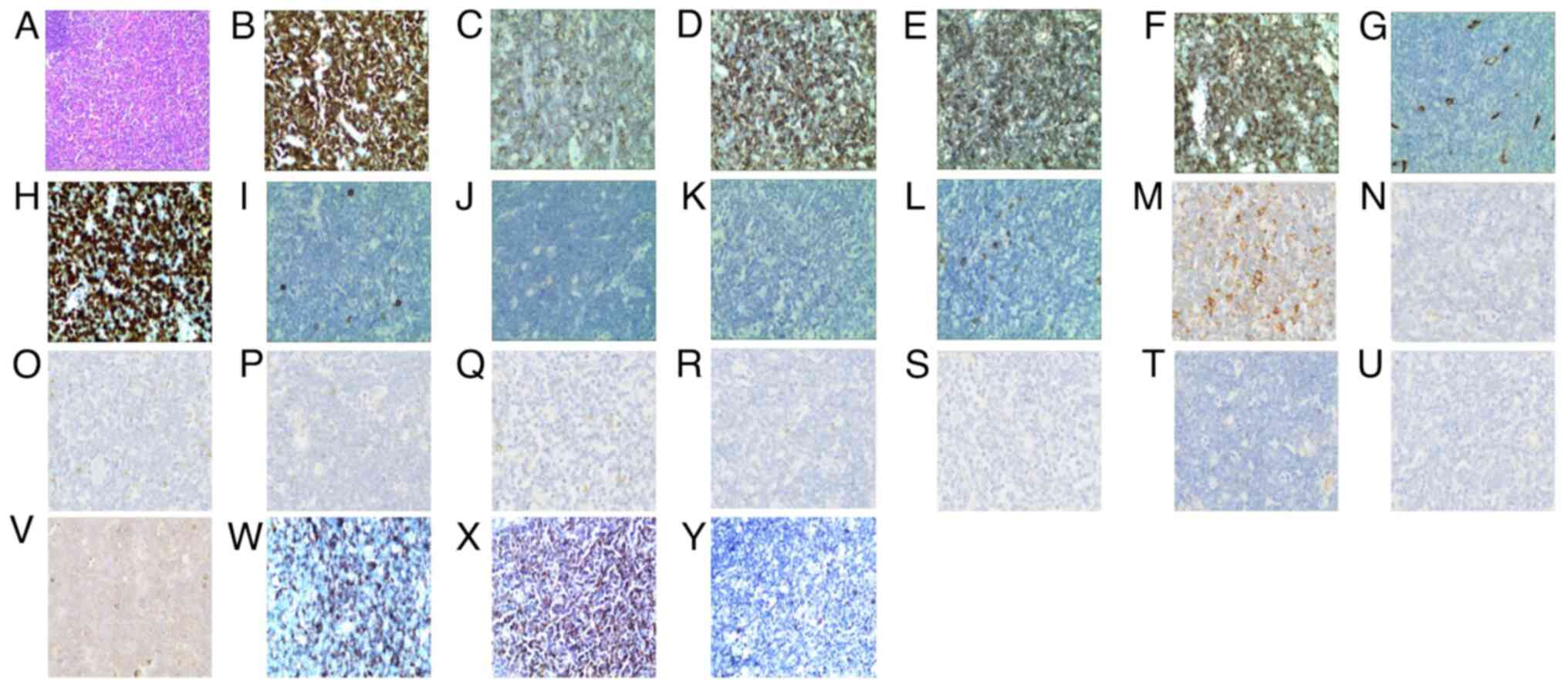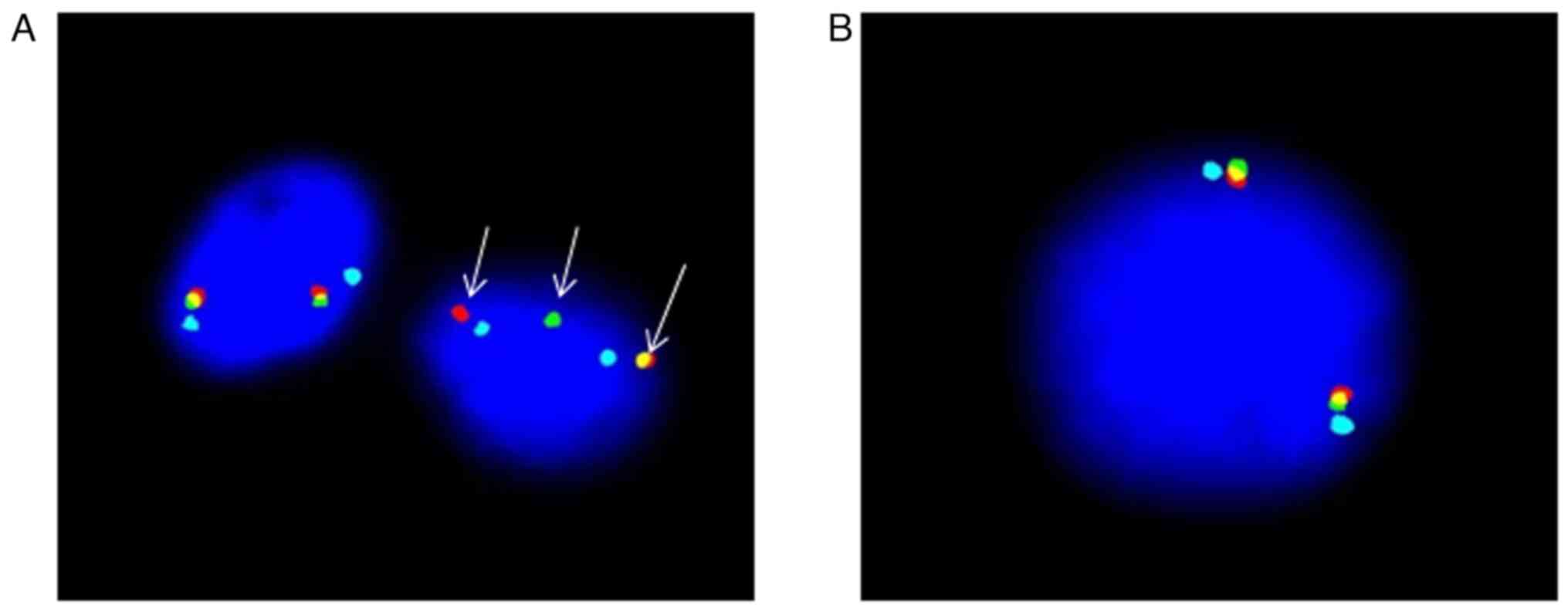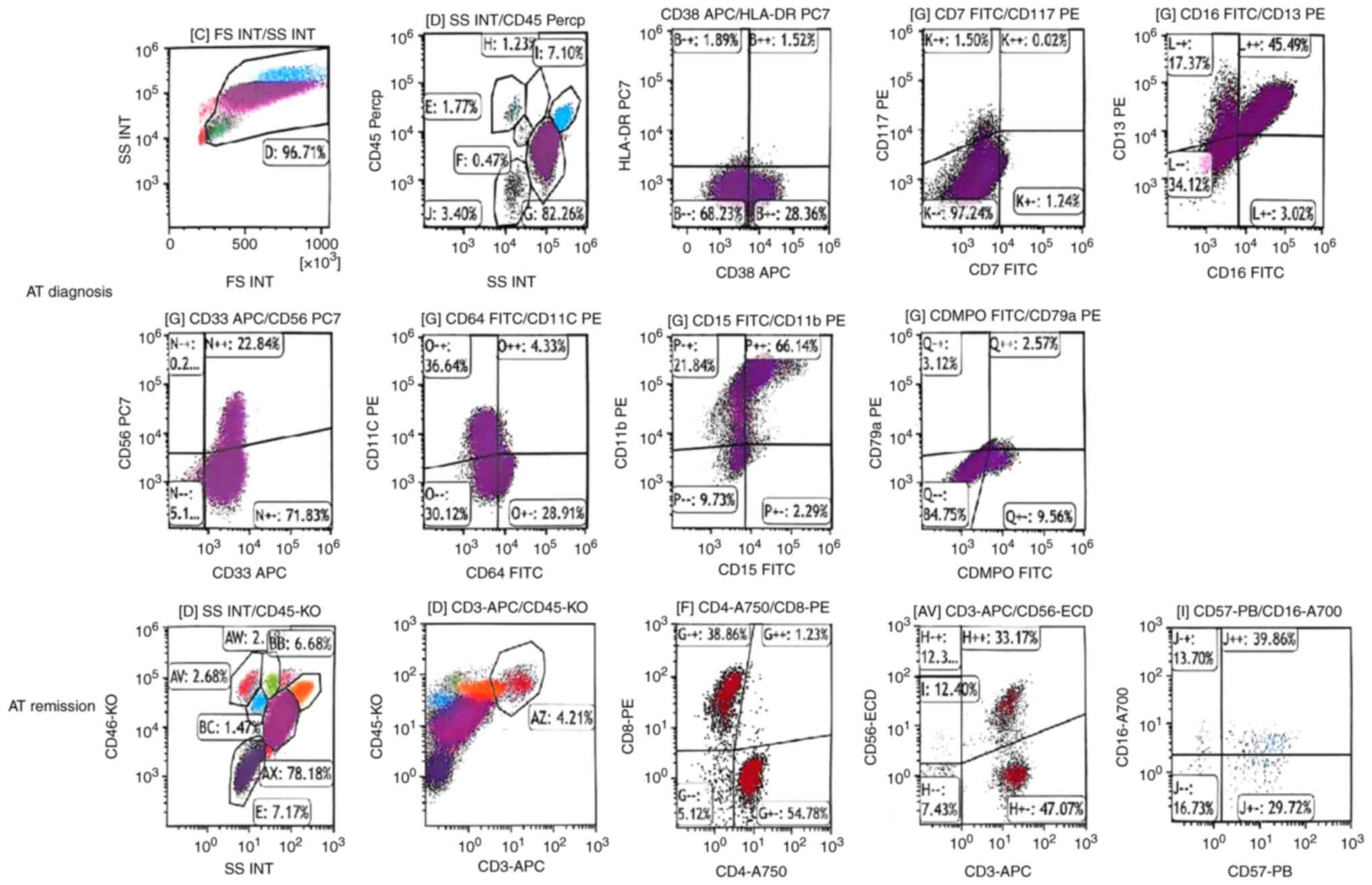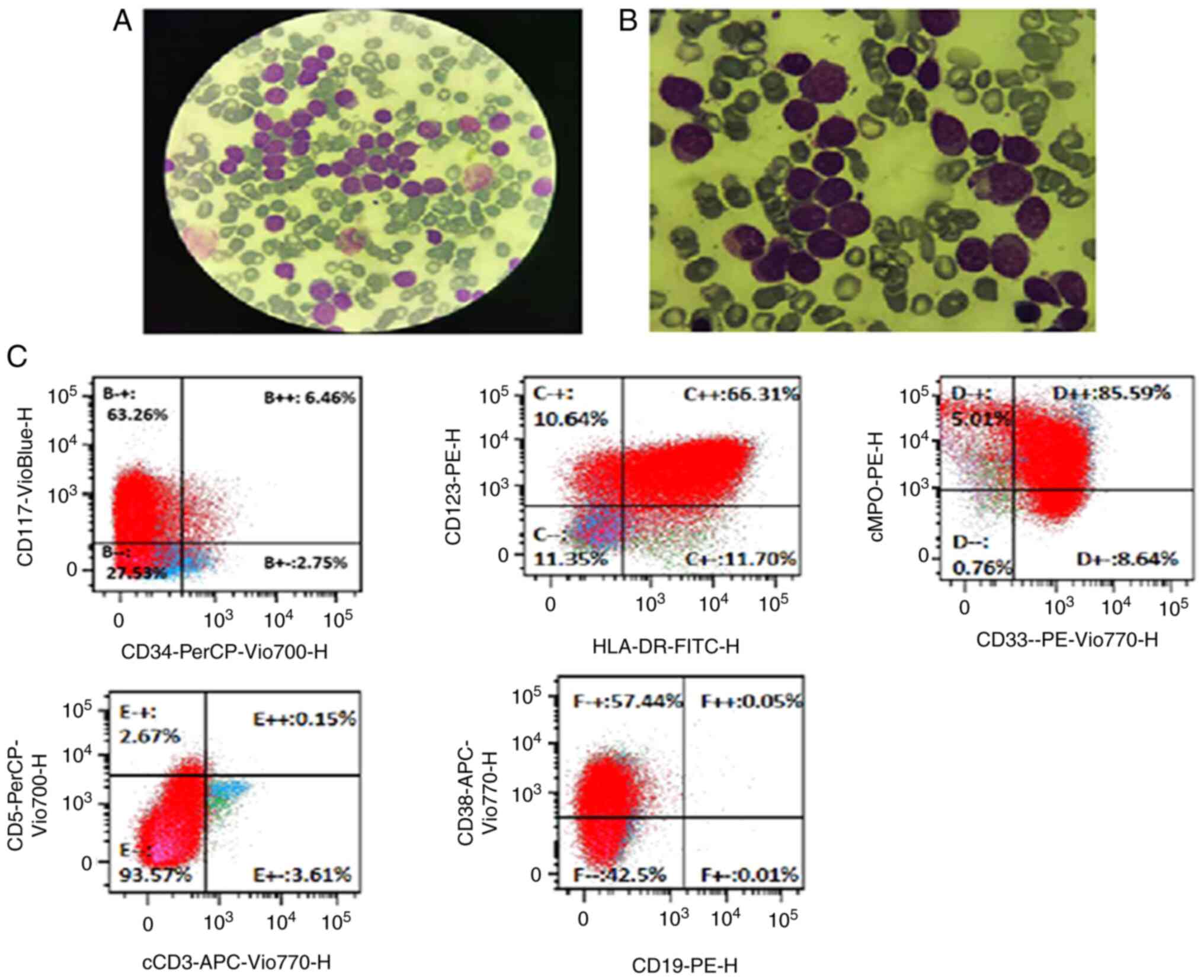|
1
|
Macdonald D, Aguiar RC, Mason PJ, Goldman
JM and Cross NC: A new myeloproliferative disorder associated with
chromosomal translocations involving 8p11: A review. Leukemia.
9:1628–1630. 1995.PubMed/NCBI
|
|
2
|
Fioretos T, Panagopoulos I, Lassen C,
Swedin A, Billström R, Isaksson M, Strömbeck B, Olofsson T,
Mitelman F and Johansson B: Fusion of the BCR and the fibroblast
growth factor receptor-1 (FGFR1) genes as a result of
t(8;22)(p11;q11) in a myeloproliferative disorder: The first fusion
gene involving BCR but not ABL. Genes Chromosomes Cancer.
32:302–310. 2001. View
Article : Google Scholar : PubMed/NCBI
|
|
3
|
Jackson CC, Medeiros LJ and Miranda RN:
8p11 myeloproliferative syndrome: A review. Hum Pathol. 41:461–476.
2010. View Article : Google Scholar : PubMed/NCBI
|
|
4
|
Li T, Zhang G, Zhang X, Lin H and Liu Q:
The 8p11 myeloproliferative syndrome: Genotypic and phenotypic
classification and targeted therapy. Front Oncol. 12:10157922022.
View Article : Google Scholar : PubMed/NCBI
|
|
5
|
Arber DA, Orazi A, Hasserjian R, Thiele J,
Borowitz MJ, Le Beau MM, Bloomfield CD, Cazzola M and Vardiman JW:
The 2016 revision to the World Health Organization classification
of myeloid neoplasms and acute leukemia. Blood. 127:2391–2405.
2016. View Article : Google Scholar : PubMed/NCBI
|
|
6
|
Abruzzo LV, Jaffe ES, Cotelingam JD,
Whang-Peng J, Del Duca V Jr and Medeiros LJ: T-cell lymphoblastic
lymphoma with eosinophilia associated with subsequent myeloid
malignancy. Am J Surg Pathol. 16:236–245. 1992. View Article : Google Scholar : PubMed/NCBI
|
|
7
|
Katoh M and Nakagama H: FGF receptors:
Cancer biology and therapeutics. Med Res Rev. 34:280–300. 2014.
View Article : Google Scholar : PubMed/NCBI
|
|
8
|
Zhang CL, Tang GS, Guo MQ, Cheng H, Liu
MD, Yang JM and Gong SL: Clinical significance of FGFR1 gene
abnormalities in blood tumors. Zhongguo Shi Yan Xue Ye Xue Za Zhi.
28:983–988. 2020.(In Chinese). PubMed/NCBI
|
|
9
|
Grand EK, Grand FH, Chase AJ, Ross FM,
Corcoran MM, Oscier DG and Cross NC: Identification of a novel
gene, FGFR1OP2, fused to FGFR1 in 8p11 myeloproliferative syndrome.
Genes Chromosomes Cancer. 40:78–83. 2004. View Article : Google Scholar : PubMed/NCBI
|
|
10
|
Zhou F, Chen S, Chao H, Zhang R, Zhou M
and Pan J: Clinical and gene involved of one case of 8p11
myeloproliferative syndrome with ins(13;8)(q12;p11p23). Zhonghua
Xue Ye Xue Za Zhi. 36:291–296. 2015.(In Chinese). PubMed/NCBI
|
|
11
|
Tiong KH, Mah LY and Leong CO: Functional
roles of fibroblast growth factor receptors (FGFRs) signaling in
human cancers. Apoptosis. 8:1447–1468. 2013. View Article : Google Scholar
|
|
12
|
Gallo LH, Nelson KN, Meyer AN and Donoghue
DJ: Functions of fibroblast growth factor receptors in cancer
defined by novel translocations and mutations. Cytokine Growth
Factor Rev. 26:425–449. 2015. View Article : Google Scholar : PubMed/NCBI
|
|
13
|
Greulich H and Pollock PM: Targeting
mutant fibroblast growth factor receptors in cancer. Trends Mol
Med. 17:283–292. 2011. View Article : Google Scholar : PubMed/NCBI
|
|
14
|
Kasyapa CS, Kunapuli P, Hawthorn L and
Cowell JK: Induction of the plasminogen activator inhibitor-2 in
cells expressing the ZNF198/FGFR1 fusion kinase that is involved in
atypical myeloproliferative disease. Blood. 107:3693–3699. 2006.
View Article : Google Scholar : PubMed/NCBI
|
|
15
|
Urrea Pineda LY, Perilla O,
Santiago-Pacheco V and Trujillo Montoya S: Myeloproliferative
syndrome with eosinophilia associated with translocation t(8; 13)
and T-cell lymphoblastic lymphoma: A case report and review of the
literature. Cureus. 14:e227342022.PubMed/NCBI
|
|
16
|
Buijs A, van Wijnen M, van den Blink D,
van Gijn M and Klein SK: A ZMYM2-FGFR1 8p11 myeloproliferative
neoplasm with a novel nonsense RUNX1 mutation and tumor lysis upon
imatinib treatment. Cancer Genet. 206:140–144. 2013. View Article : Google Scholar : PubMed/NCBI
|
|
17
|
Chen J, Deangelo DJ, Kutok JL, Williams
IR, Lee BH, Wadleigh M, Duclos N, Cohen S, Adelsperger J, Okabe R,
et al: PKC412 inhibits the zinc finger 198-fibroblast growth factor
receptor 1 fusion tyrosine kinase and is active in treatment of
stem cell myeloproliferative disorder. Proc Natl Acad Sci USA.
101:14479–14484. 2004. View Article : Google Scholar : PubMed/NCBI
|
|
18
|
Vizmanos JL, Hernández R, Vidal MJ,
Larráyoz MJ, Odero MD, Marı́n J, Ardanaz MT, Calasanz MJ and Cross
NC: Clinical variability of patients with the t(6;8)(q27;p12) and
FGFR1OP-FGFR1 fusion: Two further cases. Hematol J. 5:534–537.
2004. View Article : Google Scholar : PubMed/NCBI
|
|
19
|
Popovici C, Zhang B, Gŕegoire MJ,
Jonveaux P, Lafage-Pochitaloff M, Birnbaum D and Pébusque MJ: The
t(6;8)(q27;p11) translocation in a stem cell myeloproliferative
disorder fuses a novel gene, FOP, to fibroblast growth factor
receptor 1. Blood. 93:1381–1389. 1999. View Article : Google Scholar : PubMed/NCBI
|
|
20
|
Guasch G, Mack GJ, Popovici C, Dastugue N,
Birnbaum D, Rattner JB and Pébusque MJ: FGFR1 is fused to the
centrosome-associated protein CEP110 in the 8p12 stem cell
myeloproliferative disorder with t(8;9)(p12;q33). Blood.
95:1788–1796. 2000. View Article : Google Scholar : PubMed/NCBI
|
|
21
|
Chen MY, Shen HJ, Chao HY, Wang Q, Zhang
XW, He C, Cen JN, Chen SN, Zhang R and Zhu MQ: 8p11
myeloproliferative syndrome with CEP110-FGFR1 fusion in a child.
Zhonghua Er Ke Za Zhi. 57:297–300. 2019.(In Chinese). PubMed/NCBI
|
|
22
|
Mugneret F, Chaffanet M, Maynadié M,
Guasch G, Favre B, Casasnovas O, Birnbaum D and Pébusque MJ: The
8p12 myeloproliferative disorder. t(8;19)(p12;q13.3): A novel
translocation involving the FGFR1 gene. Br J Haematol. 111:647–649.
2000. View Article : Google Scholar : PubMed/NCBI
|
|
23
|
Manur R, Sung PJ, Loren AW, Ritchie EK,
Frank D, Bagg A, Geyer JT and Bogusz AM: Leukemic lineage switch in
a t(8;22)(p11.2;q11.2)/BCR-FGFR1-rearranged myeloid/lymphoid
neoplasm with RUNX1 mutation-diagnostic pitfalls and clinical
management including FGFR1 inhibitor pemigatinib. Leuk Lymphoma.
61:450–454. 2020. View Article : Google Scholar : PubMed/NCBI
|
|
24
|
Khodadoust MS, Luo B, Medeiros BC, Johnson
RC, Ewalt MD, Schalkwyk AS, Bangs CD, Cherry AM, Arai S, Arber DA,
et al: Clinical activity of ponatinib in a patient with
FGFR1-rearranged mixed-phenotype acute leukemia. Leukemia.
30:947–950. 2016. View Article : Google Scholar : PubMed/NCBI
|
|
25
|
Romana SP, Radford-Weiss I, Ben Abdelali
R, Schluth C, Petit A, Dastugue N, Talmant P, Bilhou-Nabera C,
Mugneret F, Lafage-Pochitaloff M, et al: NUP98 rearrangements in
hematopoietic malignancies: A study of the groupe francophone de
cytogénétique hématologique. Leukemia. 20:696–706. 2006. View Article : Google Scholar : PubMed/NCBI
|
|
26
|
Onozawa M, Ohmura K, Ibata M, Iwasaki J,
Okada K, Kasahara I, Yamaguchi K, Kubota K, Fujisawa S, Shigematsu
A, et al: The 8p11 myeloproliferative syndrome owing to rare
FGFR1OP2-FGFR1 fusion. Eur J Haematol. 86:347–349. 2011. View Article : Google Scholar : PubMed/NCBI
|
|
27
|
Belloni E, Trubia M, Gasparini P, Micucci
C, Tapinassi C, Confalonieri S, Nuciforo P, Martino B, Lo-Coco F,
Pelicci PG and Di Fiore PP: 8p11 myeloproliferative syndrome with a
novel t(7;8) translocation leading to fusion of the FGFR1 and TIF1
genes. Genes Chromosomes Cancer. 42:320–325. 2005. View Article : Google Scholar : PubMed/NCBI
|
|
28
|
Walz C, Chase A, Schoch C, Weisser A,
Schlegel F, Hochhaus A, Fuchs R, Schmitt-Gräff A, Hehlmann R, Cross
NC and Reiter A: The t(8;17)(p11;q23) in the 8p11
myeloproliferative syndrome fuses MYO18A to FGFR1. Leukemia.
19:1005–1009. 2005. View Article : Google Scholar : PubMed/NCBI
|
|
29
|
Hidalgo-Curtis C, Chase A, Drachenberg M,
Roberts MW, Finkelstein JZ, Mould S, Oscier D, Cross NC and Grand
FH: The t(1;9)(p34;q34) and t(8;12)(p11;q15) fuse pre-mRNA
processing proteins SFPQ (PSF) and CPSF6 to ABL and FGFR1. Genes
Chromosomes Cancer. 47:379–385. 2008. View Article : Google Scholar : PubMed/NCBI
|
|
30
|
Soler G, Nusbaum S, Varet B, Macintyre EA,
Vekemans M, Romana SP and Radford-Weiss I: LRRFIP1, a new FGFR1
partner gene associated with 8p11 myeloproliferative syndrome.
Leukemia. 23:1359–1361. 2009. View Article : Google Scholar : PubMed/NCBI
|
|
31
|
Wasag B, Lierman E, Meeus P, Cools J and
Vandenberghe P: The kinase inhibitor TKI258 is active against the
novel CUX1-FGFR1 fusion detected in a patient with T-lymphoblastic
leukemia/lymphoma and t(7;8)(q22;p11). Haematologica. 96:922–926.
2011. View Article : Google Scholar : PubMed/NCBI
|
|
32
|
Kim SY, Kim JE, Park S and Kim HK:
Molecular identification of a TPR-FGFR1 fusion transcript in an
adult with myeloproliferative neoplasm, T-lymphoblastic lymphoma,
and a t(1;8)(q25;p11.2). Cancer Genet. 207:258–262. 2014.
View Article : Google Scholar : PubMed/NCBI
|
|
33
|
Gervais C, Dano L, Perrusson N, Hélias C,
Jeandidier E, Galoisy AC, Ittel A, Herbrecht R, Bilger K and
Mauvieux L: A translocation t(2;8)(q12;p11) fuses FGFR1 to a novel
partner gene, RANBP2/NUP358, in a
myeloproliferative/myelodysplastic neoplasm. Leukemia.
27:1186–1188. 2013. View Article : Google Scholar : PubMed/NCBI
|
|
34
|
Nakamura Y, Ito Y, Wakimoto N, Kakegawa E,
Uchida Y and Bessho M: A novel fusion of SQSTM1 and FGFR1 in a
patient with acute myelomonocytic leukemia with t(5;8)(q35;p11)
translocation. Blood Cancer J. 4:e2652014. View Article : Google Scholar : PubMed/NCBI
|
|
35
|
Wang T, Wang Z, Zhang L, Wen L, Cai W,
Yang X, Pan J, Ruan C, Wu D, Sun A and Chen S: Identification of a
novel TFG-FGFR1 fusion gene in an acute myeloid leukaemia patient
with t(3;8)(q12;p11). Br J Haematol. 188:177–181. 2020. View Article : Google Scholar : PubMed/NCBI
|
|
36
|
Zhang X, Wang F, Yan F, Huang D, Wang H,
Gao B, Gao Y, Hou Z, Lou J, Li W and Yan J: Identification of a
novel HOOK3-FGFR1 fusion gene involved in activation of the
NF-kappaB pathway. Cancer Cell Int. 22:402022. View Article : Google Scholar : PubMed/NCBI
|
|
37
|
Liu PCC, Koblish H, Wu L, Bowman K,
Diamond S, DiMatteo D, Zhang Y, Hansbury M, Rupar M, Wen X, et al:
INCB054828 (pemigatinib), a potent and selective inhibitor of
fibroblast growth factor receptors 1, 2, and 3, displays activity
against genetically defined tumor models. PLoS One.
15:e02318772020. View Article : Google Scholar : PubMed/NCBI
|
|
38
|
Kalyukina M, Yosaatmadja Y, Middleditch
MJ, Patterson AV, Smaill JB and Squire CJ: TAS-120 cancer target
binding: Defining reactivity and revealing the first fibroblast
growth factor receptor 1 (FGFR1) irreversible structure.
ChemMedChem. 14:494–500. 2019. View Article : Google Scholar : PubMed/NCBI
|
|
39
|
Hu T, Wu Q, Chong Y, Qin H, Poole CJ, van
Riggelen J, Ren M and Cowell JK: FGFR1 fusion kinase regulation of
MYC expression drives development of stem cell leukemia/lymphoma
syndrome. Leukemia. 32:2363–2373. 2018. View Article : Google Scholar : PubMed/NCBI
|
|
40
|
Xu LP, Chen Y, Shi HX and Huang XJ: 8p11
myeloproliferative syndrome cured by allogeneic hematopoietic stem
cell transplantation: Two case reports and literature review.
Beijing Da Xue Xue Bao Yi Xue Ban. 45:993–996. 2013.(In Chinese).
PubMed/NCBI
|
|
41
|
Larosa F, Maddens S, Legrand F, Pouthier
F, Ferrand C, Saas P, Hayette S, Chabod J, Tiberghien P, Rohrlich
PS and Deconinck E: Early immune reconstitution and efficient graft
vs tumor effect after unrelated partially matched double cord blood
transplantation in refractory 8p11 syndrome. Bone Marrow
Transplant. 46:622–624. 2011. View Article : Google Scholar : PubMed/NCBI
|
















